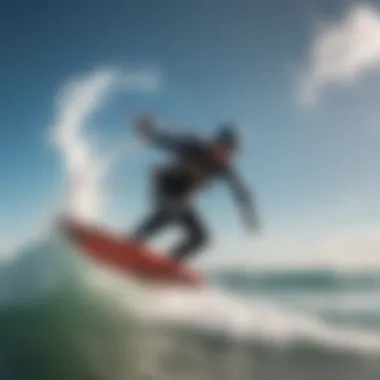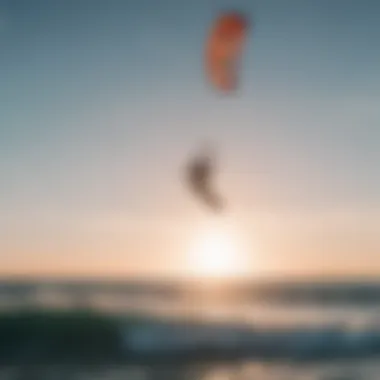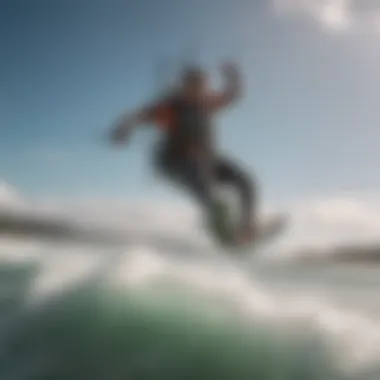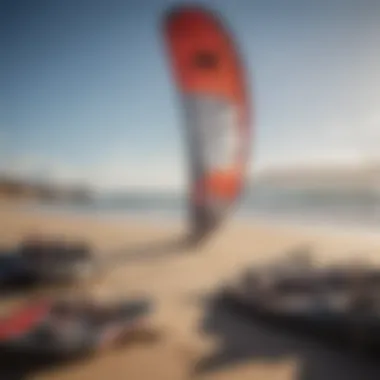Unveiling the Intricacies of Kitesurfing and Kiteboarding: A Comprehensive Guide


Equipment Reviews
When delving into the world of kitesurfing and kiteboarding, understanding the equipment is paramount. Let's start with kites - these are not your ordinary kites flying in the park on a breezy day. Kites for kitesurfing come in various shapes, sizes, and materials, each designed for specific performance levels and riding styles. From delta to bow kites, the evolution of kite designs has revolutionized the sport. Brands like Cabrinha, Naish, and Duotone dominate the market, each offering unique features that cater to different preferences.
Moving on to boards, kitesurfers have a plethora of options to choose from. Twintips boards are ideal for beginners and freestylers, providing versatility and ease of use. On the other hand, directional boards are favored by wave riders for their maneuverability and control in the surf. The construction of boards plays a significant role in their performance, with materials like carbon fiber and wood offering varying degrees of flex and responsiveness.
Accessories play a vital role in ensuring a safe and enjoyable kitesurfing experience. Harnesses keep riders connected to their kites, providing control and support during maneuvers. Quality lines ensure reliable communication between the rider and the kite, while pumps make inflation quick and effortless. Safety gear, including helmets, impact vests, and safety leashes, should never be overlooked, as they provide crucial protection in case of emergencies.
Travel Destinations
For kitesurfers and kiteboarders seeking the ultimate adrenaline rush, choosing the right location is key. Popular spots like Tarifa in Spain, Hood River in the United States, and Brazil's Cumbuco offer ideal wind conditions, flat water, and vibrant kite communities. These destinations not only provide excellent kitesurfing opportunities but also boast amenities like kite schools, rental shops, and beachfront cafes, catering to both solo travelers and families.
While popular spots have their allure, off the beaten path destinations offer a sense of adventure and discovery. Places like Dakhla in Morocco, Zanzibar in Tanzania, and the Philippines' Siargao Island provide uncrowded waters, pristine beaches, and unique cultural experiences. Kitesurfers venturing to these hidden gems can expect untouched landscapes, warm hospitality, and a chance to connect with nature on a deeper level.
Techniques and Tutorials
Mastering the art of kitesurfing and kiteboarding requires more than just adrenaline - it demands skill and precision. Beginners embarking on their kitesurfing journey can benefit from step-by-step tutorials covering essential techniques. From launching the kite safely to mastering body dragging and water relaunch, novice riders can build a solid foundation for their progress.
As riders advance in their skills, they delve into more complex maneuvers and styles. Learning to jump, perform tricks, ride waves, and explore freestyle techniques opens up a world of possibilities on the water. Techniques like upwind riding, transitions, and carving turns challenge riders to push their limits and unleash their full potential, creating a dynamic and exhilarating riding experience.
Safety Guidelines
Safety is non-negotiable in the world of kitesurfing and kiteboarding, where wind and water combine to create a thrilling yet potentially hazardous environment. Understanding weather conditions, including wind strength, current directions, tide changes, and storm patterns, is crucial for assessing risk levels and making informed decisions before hitting the water.
In the event of emergencies, having clear protocols in place can make a life-saving difference. Knowing how to self-rescue, assist others in distress, and communicate effectively with rescue teams can prevent minor incidents from escalating into serious accidents. Regular equipment maintenance, such as checking lines for wear, inspecting kite bladders for leaks, and servicing safety releases, ensures that gear functions optimally and reduces the risk of equipment failure mid-session.
Introduction to Kitesurfing and Kiteboarding
Kitesurfing and kiteboarding represent dynamic water sports that have gained immense popularity among thrill-seekers and water sports enthusiasts. These sports involve harnessing the power of the wind to propel oneself across the water's surface, combining elements of surfing, sailing, and paragliding. Understanding the basics of kitesurfing and kiteboarding is fundamental for both beginners looking to enter the sport and experienced riders aiming to refine their skills and techniques. The following sections will explore the evolution of these sports, the key differences between kitesurfing and kiteboarding, essential techniques and skills, as well as safety considerations and guidelines.
History and Evolution


Origins of Kitesurfing
Kitesurfing traces its origins back to the late 1970s and early 1980s when pioneers like Gijsbertus Adrianus Panhuise patented the first kite designs specifically for surfing. The innovative concept of using a power kite to pull the rider along waves revolutionized water sports, giving birth to the exhilarating activity we know today. The simplicity and mobility of kitesurfing allow riders to experience a unique sense of freedom and agility on the water, making it a sought-after choice for adrenaline junkies and water sports enthusiasts alike. Despite its thrilling nature, kitesurfing requires a thorough grasp of safety protocols and kite-handling skills to mitigate potential risks.
Development of Kiteboarding
Kiteboarding emerged as a distinct discipline within water sports in the 1990s, blending aspects of wakeboarding, windsurfing, and paragliding. The sport evolved as kite designs advanced, incorporating innovative features for enhanced performance and control. Kiteboarding offers riders the ability to perform spectacular aerial maneuvers and ride waves with heightened speed and agility. The fusion of kite technology with board sports has transformed the water sports landscape, attracting a diverse community of riders passionate about pushing the boundaries of what is achievable on the water. While kiteboarding delivers unmatched thrills and adrenaline rushes, mastering the technical aspects of kite control and board handling is paramount to ensuring a safe and enjoyable riding experience.
Key Differences
Distinctive Features of Kitesurfing
Kitesurfing is characterized by its utilization of a harness to attach the rider to the kite, allowing for optimal control and maneuverability. This setup enables kitesurfers to perform complex tricks and aerial stunts, leveraging the kite's power to navigate waves and execute precise directional changes. The inherent versatility of kitesurfing appeals to riders seeking a dynamic and challenging water sport that combines athleticism and skill. Despite its exhilarating nature, kitesurfing demands a high level of physical fitness and kite-handling proficiency to navigate varying wind conditions and water environments safely.
Characteristics of Kiteboarding
Kiteboarding stands out for its use of a board specifically designed for riding waves and performing freestyle tricks. Riders harness the wind's power through a control bar connected to the kite, allowing for seamless navigation and aerial maneuvers. Kiteboarding enthusiasts appreciate the sport's fusion of board control and kite handling, which opens up a world of possibilities for creative expression and skill advancement. While kiteboarding offers an adrenaline-fueled and fast-paced riding experience, riders must prioritize safety measures and equipment maintenance to avoid accidents and ensure a rewarding session on the water.
Understanding Kite Equipment
In the realm of kitesurfing and kiteboarding, understanding kite equipment stands as a fundamental pillar that shapes the entire riding experience. The significance of comprehending kite equipment lies in its role as the conduit between the rider and the elements. From choosing the right kite type to matching it with the appropriate board, a solid grasp of kite equipment ensures optimal performance and safety on the water. This section serves to unravel the intricate details behind different kite structures and board varieties, offering riders a comprehensive guide to making informed gear selections.
Kite Types
Leading Edge Inflatable (LEI) Kites
Leading Edge Inflatable (LEI) kites are renowned for their versatility and ease of use, making them a popular choice among kitesurfers and kiteboarders alike. The key characteristic of LEI kites lies in their inflatable leading edge, which provides stability and efficient relaunch capabilities on the water. This unique feature ensures that riders can easily navigate varying wind conditions while maintaining control and agility during maneuvers. The advantages of LEI kites in this article include their user-friendly nature, versatility across different skill levels, and reliability in diverse riding environments.
Ram-Air Foil Kites
Ram-Air foil kites are distinguished by their high performance and impressive lift capabilities, making them a preferred option for riders seeking increased speed and power. The key characteristic of ram-air foil kites is their multiple air chambers that enhance structural stability and aerodynamic efficiency. This design feature allows riders to achieve greater maneuverability and airtime, elevating their riding experience to new heights. While ram-air foil kites offer exceptional performance benefits, they may pose challenges in terms of setup complexity and maintenance requirements within the context of this article.
Board Varieties


Twin-Tip Boards
Twin-tip boards are celebrated for their symmetrical design, which enables riders to perform tricks and transitions effortlessly in both directions. The key characteristic of twin-tip boards lies in their bidirectional shape, enhancing maneuverability and versatility on the water. This design feature makes twin-tip boards a favorable choice for freestyle riders and those looking to explore diverse riding styles. The unique feature of twin-tip boards in this article is their ability to provide a balanced riding experience for riders of all levels, catering to both beginners and advanced enthusiasts.
Directional Boards
Directional boards are characterized by their asymmetrical shape, with a pointed nose and rounded tail that offer enhanced control in directional riding. The key characteristic of directional boards lies in their optimized performance in wave conditions, allowing riders to harness the power of the surf for exhilarating rides. This design feature makes directional boards a popular choice for wave riders and those seeking a more traditional surfing experience. The unique feature of directional boards includes their ability to carve smoothly through waves while requiring specific riding techniques to maximize their advantages within the context of this article.
Essential Techniques and Skills
Launching and Landing
Proper Setup Procedures
Proper Setup Procedures encompass the initial steps taken by riders to prepare for launching their kites and undertaking a successful ride. These procedures involve meticulously laying out the equipment, checking for any potential issues or damages, and securing all connections to ensure the kite functions optimally. The key characteristic of Proper Setup Procedures lies in their ability to enhance rider safety and kite performance. By following a systematic approach to setting up the equipment, riders reduce the risk of malfunctions and accidents, creating a secure foundation for their session. While Proper Setup Procedures may require time and attention to detail, their importance cannot be overstated in maintaining a controlled and controlled kiteboarding experience.
Safe Landing Techniques
Safe Landing Techniques play a pivotal role in ensuring a smooth and controlled end to a kiteboarding session. These techniques involve skillfully de-powering the kite, controlling its descent, and safely landing it on the water or land. The key characteristic of Safe Landing Techniques is their emphasis on rider safety and equipment protection. By mastering these techniques, riders can decrease the likelihood of crashes or damage to their gear, prolonging the lifespan of their equipment. Additionally, understanding and implementing Safe Landing Techniques contribute to a rider's overall confidence and competence in handling kite landings, fostering a sense of security and proficiency throughout their sessions.
Riding Maneuvers
Upwind Riding Techniques
Upwind Riding Techniques focus on the ability of riders to navigate their kites against the wind direction, allowing them to make progress upwind during their sessions. The key characteristic of these techniques is their significance in optimizing a rider's efficiency and reach on the water. By mastering Upwind Riding Techniques, riders can extend their time on the water, explore new locations, and challenge themselves by riding in varying wind conditions. The unique feature of Upwind Riding Techniques lies in their strategic use of kite positioning and body posture to harness the wind's power effectively, propelling the rider against the natural flow. While mastering Upwind Riding Techniques may require practice and persistence, the benefits of increased control and versatility make them a valuable skill for riders to develop.
Turning and Carving
Turning and Carving techniques form the core of fluid and dynamic kiteboarding maneuvers, enabling riders to change directions smoothly and execute agile turns on the water. The key characteristic of these techniques is their contribution to enhancing a rider's style, speed, and overall performance during sessions. By mastering Turning and Carving, riders can add finesse to their riding, maneuver around obstacles with ease, and maximize their enjoyment on the water. The unique feature of Turning and Carving lies in the precise control and body positioning required to execute seamless turns and arcs, showcasing a rider's proficiency and skill level. While perfecting Turning and Carving techniques may demand dedication and coordination, the rewards of increased agility and expression on the water make them an essential component of a rider's skill set.
Safety Considerations and Guidelines


In the thrilling realm of kitesurfing and kiteboarding, prioritizing safety considerations and adhering to guidelines is paramount. Understanding the risks involved and implementing proper safety measures can make a massive difference in ensuring a safe and enjoyable riding experience. Safety considerations encompass a spectrum of elements, from equipment checks to weather conditions, all aimed at minimizing the chances of accidents or injuries on the water.
Maintaining an acute awareness of weather patterns is crucial for kitesurfers and kiteboarders alike. Clear comprehension of wind conditions allows riders to plan and execute their sessions effectively, maximizing their time on the water. Strong gusts or sudden changes in wind direction can pose significant challenges, underscoring the need for riders to be attuned to these nuances to navigate safely and confidently.
Weather Awareness
Understanding Wind Conditions
When delving into the specifics of understanding wind conditions, it becomes evident that wind direction, speed, and consistency play pivotal roles in the kitesurfing and kiteboarding domain. By comprehending these factors, riders can harness the wind's power efficiently, propelling themselves across the water with finesse and control. Understanding wind conditions empowers riders to make informed decisions regarding their equipment choice and riding techniques, facilitating a seamless and enjoyable experience on the waves.
Monitoring Weather Forecasts
Monitoring weather forecasts emerges as a crucial component of operational preparedness for kitesurfers and kiteboarders. By staying abreast of impending weather patterns, riders can proactively adjust their plans, safeguarding themselves against sudden adverse conditions. Regularly checking weather forecasts enables riders to optimize their sessions, selecting the ideal time and location to indulge in their high-octane water sport pursuits.
Considering emergency procedures is a non-negotiable aspect of kitesurfing and kiteboarding, aligning with the adage that better safe than sorry. Acquiring proficiency in self-rescue techniques equips riders with the skills necessary to extricate themselves from challenging situations, fostering self-reliance and confidence on the water. Additionally, understanding how to communicate distress signals effectively ensures that riders can quickly garner assistance if the need arises, fostering a collective culture of safety and support within the kitesurfing and kiteboarding community.
Immersing in the Kitesurfing Lifestyle
In this article, the section on Immersing in the Kitesurfing Lifestyle plays a pivotal role in providing readers with a comprehensive understanding of the broader kitesurfing and kiteboarding culture. It delves into the various elements that define this lifestyle, shedding light on the significance of not just the physical aspect of the sports, but also the mental and social components that enthusiasts experience. Immersing oneself in the kitesurfing lifestyle goes beyond merely engaging in the activities; it encompasses embracing a community, adapting to unique travel destinations, and investing in the requisite gear and apparel that enhance the overall experience.
Travel Destinations
Exotic Kitesurfing Hotspots
The subtopic of Exotic Kitesurfing Hotspots within the Travel Destinations section serves as a tantalizing exploration of some of the most exotic and sought-after locations for kitesurfing and kiteboarding. These hotspots are characterized by pristine beaches, consistent wind conditions, and breathtaking natural landscapes that provide the perfect backdrop for adrenaline-fueled water sports. Their allure lies in not just the quality of the kiteboarding experience they offer but also in the immersive cultural encounters and adventures they provide to enthusiasts. While these locations may require more logistical planning and potentially higher costs, the unparalleled beauty and unique kitesurfing conditions they offer make them a top choice for riders looking to elevate their experience to new heights.
Community-Favorite Locations
Within the Travel Destinations section, Community-Favorite Locations emerge as the heartbeat of the kitesurfing community. These spots are popular amongst riders for reasons beyond just the wind and water conditions; they embody a sense of camaraderie and shared passion among kitesurfing enthusiasts. Community-Favorite Locations often host events, gatherings, and training sessions where riders can come together to hone their skills, exchange experiences, and forge lasting connections with like-minded individuals. While they may not always boast the most exotic settings, these locations offer a sense of belonging and solidarity that enhances the kitesurfing lifestyle, fostering a supportive and thriving community of riders.
Gear and Apparel
Essential Equipment Checklist
In the Gear and Apparel section, the focus shifts to the practical aspects of kitesurfing and kiteboarding, specifically the essential equipment checklist that every rider must adhere to. This checklist outlines the core gear required for a safe and enjoyable riding experience, including kites, boards, harnesses, safety leashes, and protective gear. Each item on the checklist serves a crucial purpose in ensuring rider safety and comfort on the water, underscoring the significance of thorough preparation and attention to detail before embarking on any kitesurfing session.
Performance Enhancing Gear
Complementing the essential equipment checklist, the discussion on Performance Enhancing Gear elucidates the role of advanced gear and accessories in optimizing rider performance. These specialized tools, such as high-performance kites, hydrofoil boards, and specialized wetsuits, are designed to elevate riders' abilities, enhance maneuverability, and maximize speed and control on the water. While performance enhancing gear may come at a premium cost, their contributions to the overall riding experience are substantial, allowing riders to push their limits, experiment with new tricks, and progress in their kitesurfing journey.







